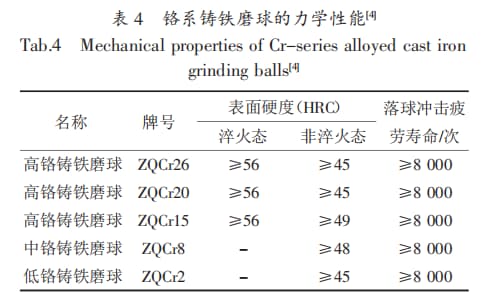Casting Production of Chromium Series Cast Iron Grinding Balls (2)
3.Matrix structure and mechanical properties
3.1 Matrix structure
(1) Carbide and Martensite
The microstructure of the chromium grinding balls are mainly carbide, and the carbide of high hardness in white cast iron is Fe3C, Cr3C, (Fe, CR)3C, Cr7C3, Cr22C6, WC, TiC, etc. , therefore, the size, number, distribution, shape of the grinding ball has a direct impact on the performance.
MARTENSITE is a solid solution of supersaturated carbon dissolved in bcc-Fe. It is an unstable quenched structure. Its hardness depends on the amount of W (C).
(2) Pearlite and Bainite
Pearlite is a mixture of ferrite and cementite. With the increase of W (C), the cementite in the Matrix increases. Sorbitol, troostite, and troostite are the best pearlite after quenching and tempering. There is also the use of grinding ball heat quenching, tempering to obtain pearlite. Bainite is also a mechanical mixture of ferrite and cementite.
The morphology of bainite varies with the isothermal temperature, with feathery upper bainite formed at 550ー350 °C and Black acicular lower bainite formed at 350ー MS, which is a kind of structure with good wear resistance.
3.2 Mechanical property
The mechanical properties of chromium cast iron grinding ball are shown in Table 4
4.Melting Process
At present, few factories adopt single cupola melting, most of them adopt Cupola —— Induction furnace duplex melting or induction furnace melting
4.1 Smelting of low and medium chromium cast iron
1) the melting speed should be controlled as far as possible, the melting time should be shortened, and the high temperature holding time should be reduced. It is strictly forbidden to melt low and medium chromium cast iron by melting cast steel. When melting, it is kept at about 1400 °C and covered with a coating layer (agent).
2) scrap, scrap iron, scrap, and other charges should be as far as possible to use the drum to remove rust, impurities; attention should be paid to scrap, the composition of the charge, and special elements; if the dosage is more than 50%, it is better to add some new pig iron in the burden, which can be added at the time of feeding, or after melting and before slagging
3) in order to increase the amount of scrap steel, it is necessary to add the carburizing agent (note the quality of commercial carburizing agent, use the carburizing agent with low nitrogen content). The carburizing agent can be added at the time of charging or at the temperature of molten iron from 1400 °C to 1450 °C.
4) melting with acid furnace lining (SIO2) induction furnace, after melting and cleaning, adding Alkali slag-removing covering agent.
4.2 Smelting of high chromium cast iron
Melting of high chromium cast iron with an acid medium frequency induction furnace, the main charge is high chromium cast iron, Vanadium titanium pig iron, scrap steel, # 1 rare earth silicon iron, manganese iron, etc. , the pouring temperature is 1350 ~ 1400 °C. Rare Earth Alloy is added directly into the furnace or Ladle 5 ~ 10 min before discharging. All burden to analyze the composition, clean, non-greasy rust.
5.Casting Method
Recently, chromium grinding balls manufacturers generally use metal, graphite, lost foam dry sand vacuum modeling more.
1) Metal type
Single-ball process, used for large grinding balls with diameters of 100 ~ 120 mm or 130 mm, with risers and insulating sand sleeves (the sleeves can be made of fly ash fired from thermal power plants with sodium silicate or resin as a binder), double-ball process, the big ball is divided vertically into one type with two or more balls (the first type can hold 8 ~ 12 balls with diameter < 60mm), it can adopt constant pressure equal flow pouring system, horizontal parting, single-layer arrangement, sand insulation cover in the middle pouring riser (the process is similar to sand mold), stack-box molding pouring, used for small balls with ball diameter, not more than 40mm, each type can be placed 6 ~ 8 balls, stack type takes 6 ~ 8 layers, sand core, and riser sleeve are used in the middle.
And since 2013, as the development of the casting chrome grinding balls industry, metal mold goes popular and developed further. Besides, the manual grinding balls metal mold and the automatic casting grinding balls molding line, which adopts sand coated the cavity of the metal mold technology, are welcomed in the grinding balls foundry. The chilling process produced balls have a much better wear rate and finer inner structure and good mechanical property. The market occupancy rate reaches over 95% in China.
2) Graphite type
The process is similar to that of a metal mold and is made of graphite. Adopting horizontal or vertical parting, it has the advantages of rapid casting speed, smooth grinding ball surface, fine and uniform grinding ball matrix.
3) Lost foam
The process is similar to that of a metal mold and is made of graphite. Adopting horizontal or vertical parting, it has the advantages of rapid casting speed, smooth grinding ball surface, fine and uniform grinding ball matrix.
Conclusion:
With the development of cement production, the diameter of the ball mill increases so does the diameter of chromium grinding balls. With the demand of powder refinement, the ball mill with small diameter (< 30mm) is needed, which promotes the continuous development of metal type molding casting grinding ball technology

